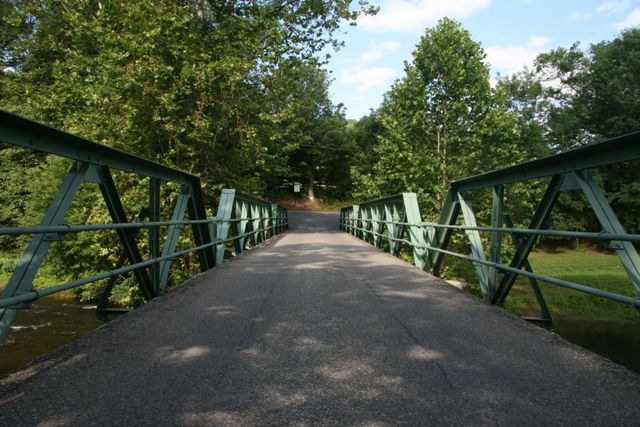We Recommend:
Bach Steel - Experts at historic truss bridge restoration.
BridgeHunter.com Phase 1 is released to the public! - Visit Now
Kiceniuk Road Bridge

Primary Photographer(s): Nathan Holth and Rick McOmber
Bridge Documented: July 11, 2008
Rural: Hunterdon County, New Jersey: United States
1995
48.0 Feet (14.6 Meters)
150.0 Feet (45.7 Meters)
12.5 Feet (3.81 Meters)
3 Main Span(s)
10XXF72

View Information About HSR Ratings
Bridge Documentation
View Archived National Bridge Inventory Report - Has Additional Details and Evaluation
This bridge is one of Hunterdon County's unusually large population of multi-span pony truss bridges. Multi-span pony trusses are uncommon in other parts of the country, where single span pony trusses are usually the only type of pony truss commonly found, with most multi-span truss bridges being through trusses.
Among the county's multi-span pony trusses, this bridge is particularly noteworthy because it is three spans instead of two. The bridge also retains a good deal of historic integrity with no major alterations to deface the historic appearance of the bridge. Pole railings on the bridge are original. The bridge is an example of a truss bridge design that was employed in various parts of the United States mostly between 1905 and 1920, which is a lightweight but fairly sturdy truss composed of built-up beams which primarily use just angles riveted together, instead of things like channels, riveted to v-lacing, lattice, etc. These "riveted angles" truss bridges have a distinct, more plain appearance than their more traditionally composed counterparts. Some states and regions exhibit more examples of this bridge form than others.
Information and Findings From New Jersey's Historic Bridge InventoryDiscussion of Bridge The 3-span (50'-long spans) riveted Warren with verticals pony truss bridge is supported on random ashlar abutments with wingwalls and piers. It is composed primarily of angles, and the riveted outriggers are original, as is the pipe railing. The only alterations appear to be toe walls added to the piers, concrete seats, and encasing the west abutment. Although the bridge is a late example of its type, it is will preserved and the 3 span configuration demonstrates the adaptability of truss bridges to diverse sittings. This adaptability contributed to the popularity, marketability, and continue use of this bridge type and hence, to its significance. It is individually eligible for listing in the National Register under Criterion C. Discussion of Surrounding Area The bridge carries one lane of a lightly traveled country road over the South Branch of the Raritan River. The bridge is located adjacent to a park and nature preserve. The sparsely developed wooded rural setting is unspoiled. Bridge Considered Historic By Survey: Yes |
![]()
Photo Galleries and Videos: Kiceniuk Road Bridge
Bridge Photo-Documentation
Original / Full Size PhotosA collection of overview and detail photos. This gallery offers photos in the highest available resolution and file size in a touch-friendly popup viewer.
Alternatively, Browse Without Using Viewer
![]()
Bridge Photo-Documentation
Mobile Optimized PhotosA collection of overview and detail photos. This gallery features data-friendly, fast-loading photos in a touch-friendly popup viewer.
Alternatively, Browse Without Using Viewer
![]()
Maps and Links: Kiceniuk Road Bridge
Coordinates (Latitude, Longitude):
Search For Additional Bridge Listings:
Bridgehunter.com: View listed bridges within 0.5 miles (0.8 kilometers) of this bridge.
Bridgehunter.com: View listed bridges within 10 miles (16 kilometers) of this bridge.
Additional Maps:
Google Streetview (If Available)
GeoHack (Additional Links and Coordinates)
Apple Maps (Via DuckDuckGo Search)
Apple Maps (Apple devices only)
Android: Open Location In Your Map or GPS App
Flickr Gallery (Find Nearby Photos)
Wikimedia Commons (Find Nearby Photos)
Directions Via Sygic For Android
Directions Via Sygic For iOS and Android Dolphin Browser
USGS National Map (United States Only)
Historical USGS Topo Maps (United States Only)
Historic Aerials (United States Only)
CalTopo Maps (United States Only)

